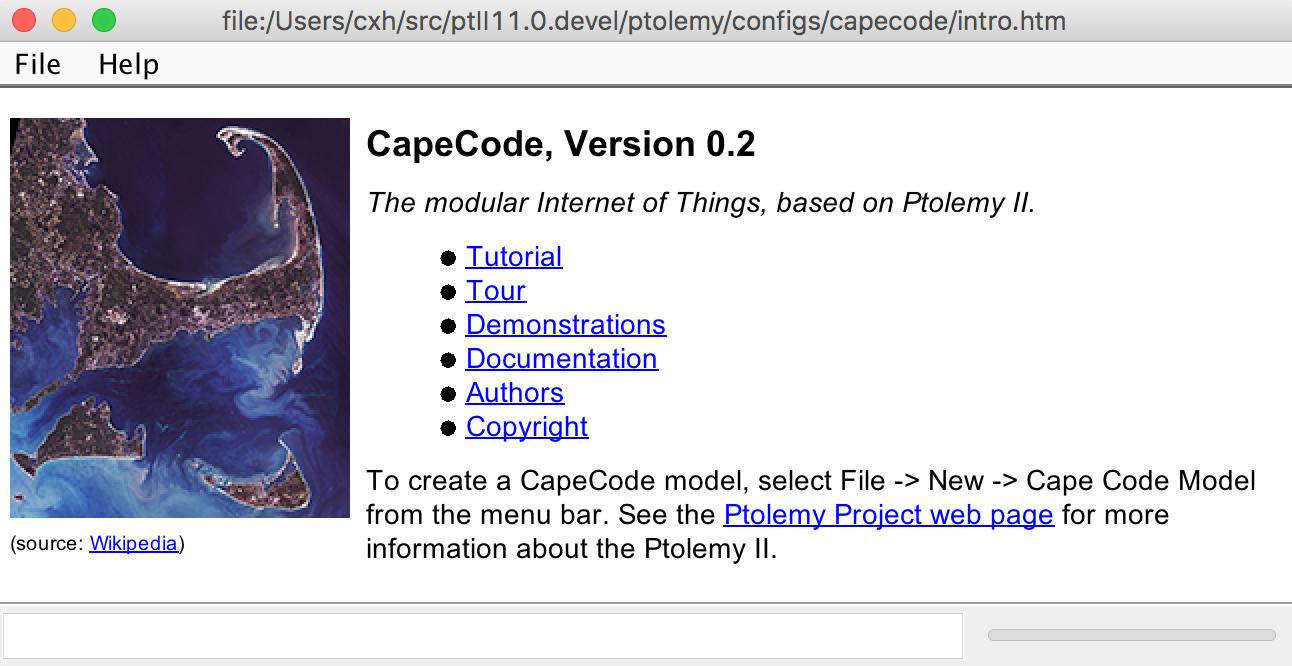
|
Main /
Ptolemy II/CapeCode(This page may be found at http://accessors.org/wiki/Main/PtolemyII) The CapeCode Accessor Host is an extension of http://ptolemy.org/ptolemyII, an actor-oriented modeling and design environment. For a tutorial on CapeCode, see the tutorial page. An example of a swarmlet rendered in Vergil, the graphical block-diagram editor for Ptolemy II, is:  This block diagram realizes a simple augmented-reality application that identifies devices or services in the field of view of a video camera and dynamically instantiates an accessor that provides an interface to the device or service. Following the instructions below, you can run this application. Installing Ptolemy II and CapeCodeTo use the most recent Accessors work, you should install the repository version, not the 10.0 release because we will be relying on up-to-the-minute updates. If you are unable to do this, the nightly build installers will be far more up-to-date than 10.0 release. Windows users: see the CapeCode Windows Installation instructions. Installing the most up-to-date version of CapeCode using GitMake sure you have a recent Java Development Kit (JDK) installed. At this time, Java 1.8 (aka Java 8) is preferred over Java 9 for building from sources. The installers will not work with Java 9. To build from sources, the javac -version You should see something like "javac 1.8.0_152". Then download and build Ptolemy II: git clone --depth=50 --branch=master --single-branch https://github.com/icyphy/ptII cd ptII export PTII=`pwd` ./configure $PTII/bin/ant $PTII/bin/vergil Notice that the third line sets an environment variable PTII. You may wish to set that environment variable in your command-line profile so that it is always available. For example, I have in my .bash_profile file in my home directory the following line: export PTII=/Users/eal/ptII Anytime after intalling Ptolemy II, you can update to the latest version as follows: cd $PTII git pull $PTII/bin/ant Installing CapeCode using prebuilt installersIf the above fails or is too difficult for some reason, you can use the installers from the nightly build as explained below. This will give you the most up-to-date version at the time you perform the installation, but to update to a newer version, you will have to reinstall. This is why installing from the Git repository as above is preferred.
For more information, see the more detailed instructions. If you plan to do any Java programming to extend Ptolemy II, then we recommend installing Eclipse and setting up Ptolemy II as a Java project. Running CapeCodeOnce you have installed Ptolemy II, you can run CapeCode with the following command: $PTII/bin/capecode This will bring up the welcome window, which looks like this:  We suggest browsing the links here, particularly the Tour. To directly execute a simple demo that uses your machine's built-in camera, try: $PTII/bin/capecode $PTII/ptolemy/actor/lib/jjs/modules/imageFilters/demo/imageFilters/Random.xml Tutorial documents and solutions are available with the following command: $PTII/bin/capecode $PTII/ptolemy/demo/CapeCode/CapeCode.xml To execute a more interesting demo that creates a networked application, try: $PTII/bin/capecode $PTII/ptolemy/actor/lib/jjs/modules/webSocket/demo/WebSocketChat/Client.xml This demo is a chat client. The comments in the demo include a link to the chat server, which you must also run for the chat client to work. Click on the annotation that mentions the Server model and the run the Server model by clicking on the Run icon in the tool bar (it looks like play button). Then you can run the chat client and type into the dialog. You can start any number of chat clients and they will all connect to the same chat server. The chat server uses WebSockets to communicate with all clients. You can browse these models and open each of the icons (right click and select Open Actor) to see how the accessors are implemented. See Also |